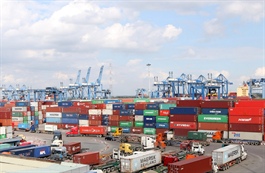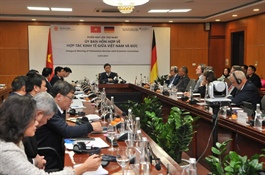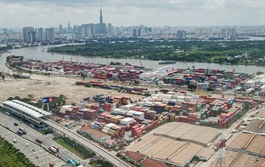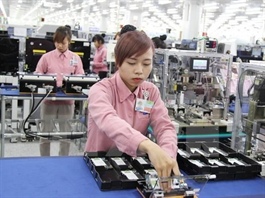Legal issues cloud LNG power plans
Legal issues cloud LNG power plans
The concept of using liquefied natural gas (LNG) for electricity production is attracting investors in Vietnam. ACSV Legal managing partner Mark Oakley, of counsel, and head of Energy Practice Tim Dobson provide a look into the current LNG-to-power market of Vietnam and outline some critical legal issues for interested investors.

ACSV Legal managing partner Mark Oakley, of counsel, and head of Energy Practice Tim Dobson
|
In February 2020 the Politburo issued Resolution No.55/NQ-TW on the national energy development strategy until 2030 with a vision to 2045. In this, the goal was set out to develop infrastructure with sufficient capacity to import about eight billion cubic metres of LNG in 2030 and 15 billion cu.m in 2045.
As evidenced by Resolution 55, Vietnam is intent on developing LNG-to-power projects due to an anticipated power shortage in southern Vietnam from 2021-2025 caused by many reasons. So far, no LNG power plants have begun commercial operation in Vietnam.
Several large-scale LNG-to-power projects have been included in the National Power Development Plan VII (PDP7) in many provinces. Among those, the initiative in the Mekong Delta province of Bac Lieu developed by Delta Offshore Energy stands out due to its large capacity of 3,200MW and the fact it is the first LNG power plant developed as an independent power producer (IPP) under the Law on Investment (meaning a private entity owning power plant facilities to generate power for sale).
There are also other large-capacity ventures being proposed for inclusion in PDP8, such as that in Chan May-Lang Co Economic Zone in the central province of Thua Thien-Hue with a capacity of about 4,000MW and multiple LNG power plants in South Van Phong Industrial Zone, in the south-central province of Khanh Hoa.
Other than general laws regulating foreign investment, the government has only issued Decree No.87/2018/ND-CP to regulate business activities (trading, import, and transport) related to LNG. The conditions to trade, import, and transport LNG in Decree 87 are general and need further guiding regulations for practical implementation. Of note, Decree 87 also does not mention the use of floating storage and/or regasification units or facilities in LNG activities, which is a notable omission, since it is not clear how the government would manage and regulate such facilities.
Potential structures
There are two regulatory frameworks to develop an LNG-to-power project, being public-private partnership (PPP) laws and the Law on Investment. If selected as the developer of a PPP venture following the tendering process under the Law on Bidding, the sponsors and a competent governmental authority will enter into a concession agreement, commonly in the form of build-operate-transfer (BOT), to allocate risks.
For non-PPP IPP under the Law on Investment, sponsors will develop under the Law on Investment without a concession agreement. Sponsors choosing the PPP framework for BOT typically must wait a much longer time to be officially selected as the developer than the non-PPP framework. But in return, PPP developers generally receive better government support, especially in terms of power purchase agreement (PPA) bankability and government guarantees which are required to obtain non-recourse project financing from foreign lenders.
The fundamental difference between PPP projects, which are nearly always BOT, and IPP ones under the Law on Investment will be that under a PPP BOT project Electricity of Vietnam (EVN) will end up owning the power plant facilities, whereas under an IPP one, EVN is simply buying power, and this has an impact on what is included in the PPA for an IPP scheme.
Vietnamese law also requires many regulatory approvals in different fields such as power, environment, and corporate. The final decision heavily depends on discretion of the licensing authorities.
Meanwhile, after issuance of the investment registration certificate for non-PPP IPP projects or signing of concession agreement for PPP BOT equivalents, the sponsors must set up a project company in Vietnam to start implementing it.
For non-PPP projects, the equity or charter capital amount normally must be no less than 15 per cent (for those using more than 20 hectares of land) or 20 per cent (for those using less than 20 hectares of land) of the total capital. By law, sponsors must contribute the entire charter capital amount of the project company within 90 days from incorporation date. For PPP initiatives, the owner’s equity amount must be at least 15 per cent of total investment capital and be contributed following schedules provided in the concession agreement.
Power projects under the PPP BOT umbrella have in the past been able to use a relatively detailed and sophisticated PPA containing terms necessary to achieve bankability acceptable by international lenders. However, for non-PPP IPP schemes, strictly speaking, the contents of the PPA should follow the template PPA issued by the Ministry of Industry and Trade (MoIT) under Circular No.56/2014 dated December 2014, as amended.
Unfortunately, the template PPA in Circular 56 is too simple for an LNG-to-power project and not sufficiently bankable to obtain non-recourse financing from foreign lenders. Although Circular 56 suggests that the template PPA can be amended, the extent of amendments acceptable to the Vietnamese authorities remains to be seen, and we are not aware of any Circular 56 PPAs that have been signed which matches the sophistication and detail of the PPA granted to PPP BOT projects.
Whether a non-PPP IPP developer can have a detailed and bankable PPA that satisfies foreign lenders will depend heavily on the cooperation of EVN, the MoIT, and the government.
Allocations and rights
Integrated LNG-to-power ventures will require sea or coastal areas to place vessels, terminals, and underwater pipelines for transporting LNG. To obtain the title to use sea areas offshore, the developer will need to apply for approval to use the sea areas in accordance with Decree No.51/2014/ND-CP released in May 2014 on providing the assignment of given sea areas to organizations and individuals for marine resource exploitation and use.
Decree 51 and its guiding regulations are not clear in determining the sea use fees, sea areas and licensing regulations to use sea areas, resulting in a lengthy process to allocate sea areas to a developer and brings with it additional expenses for developers. Decree 51 also does not contain any provisions on whether the developer can use the allocated sea, coastal area, and offshore facilities as security assets for project financing. It is expected that the decree replacing Decree 51, which is being drafted, will resolve the shortcomings.
Elsewhere, under the Law on Land, the land use rights can only be mortgaged if the project company uses the land with land rent being paid in full and upfront. For those companies that pay land rent annually or are exempted from it (treated the same as paying rent annually), they can only mortgage assets attached to the land. Lenders usually prefer mortgages of both land use rights and the assets attached thereto.
Further, the Law on Land only allows companies to mortgage land use rights and assets attached to land to credit institutions operating in Vietnam. Up until now, foreign lenders have used a bank in Vietnam acting as the security agent on behalf of the lenders to receive the mortgage and foreclose the mortgaged assets if required. While this has been accepted practice in the past, the legality of such arrangement is unclear and has yet to be confirmed by the authorities.
Since this is likely to be an important issue for foreign lenders, the parties will need to explore ways that this problem can be legally solved - for example have a local bank included as one of the lenders.
Without a doubt, LNG-to-power projects will play a major role in the power market of Vietnam in the future. Although, to ensure sustainable development and interest of investors, more must be done, such as development of a more concrete and streamlined legal framework and provision of better support to developers.
Until the LNG market in Vietnam becomes more developed, pioneer sponsors and financiers will face certain legal and practical issues in developing and financing an LNG-to-power scheme. However, these are not insurmountable, and it will be interesting to see how the current LNG-to-power projects currently working their way through the system fare.






















